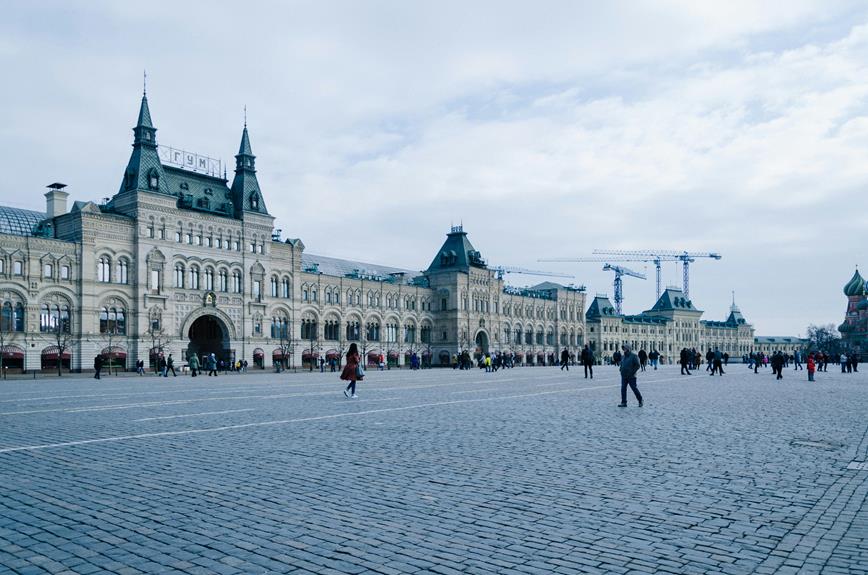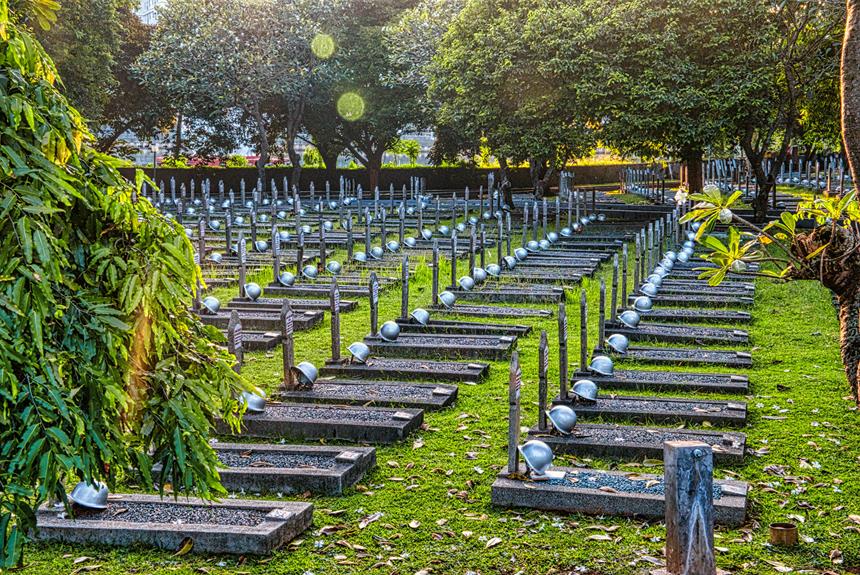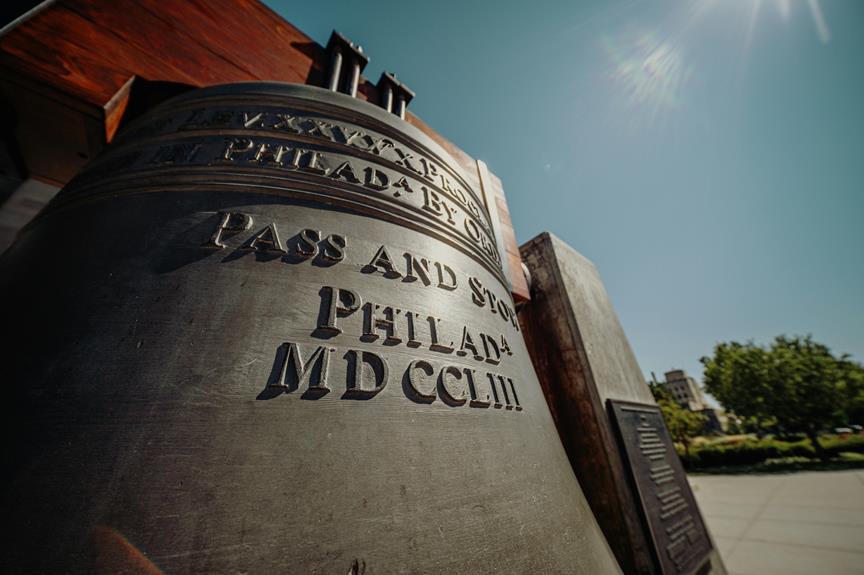The Museum of the Great Patriotic War in Russia stands as a solemn tribute to the enduring legacy of valor and sacrifice witnessed during World War II. Its collection of artifacts and immersive exhibits offers a compelling glimpse into the harrowing realities faced by those who lived through this tumultuous period. As visitors navigate through the museum's halls, they are transported back in time to an era defined by resilience and unwavering determination. With each display, the untold stories of heroism and solidarity unfold, painting a vivid picture of a nation united in the face of adversity.
Key Takeaways
- Exhibits showcase military uniforms, propaganda posters, and personal belongings from WWII.
- Interactive VR experience offers immersive storytelling of key battles and wartime settings.
- Honors Soviet Union's war efforts, including propaganda campaigns and strategic military operations.
- Features stories of bravery and sacrifice, highlighting individual acts of courage.
- Displays heroic memorials, sculptures, and monuments honoring soldiers' sacrifices.
History of the Great Patriotic War
The history of the Great Patriotic War, a pivotal chapter in Russia's military past, is marked by significant events that shaped the course of World War II in the Eastern Front. This conflict, fought between the Soviet Union and Nazi Germany from 1941 to 1945, was characterized by intense wartime struggles and the implementation of innovative military tactics.
During the Great Patriotic War, the Soviet Union faced brutal invasions and immense human losses. The Eastern Front became a battleground where millions of soldiers and civilians perished, illustrating the grim realities of war. The Soviet forces had to adapt their military tactics rapidly to counter the German onslaught, leading to the development of new strategies such as scorched earth policy, partisan warfare, and mass mobilization of resources.
One of the most notable wartime struggles of the Great Patriotic War was the Battle of Stalingrad. This grueling confrontation, lasting from August 1942 to February 1943, resulted in catastrophic casualties but ultimately marked a turning point in the conflict. The Soviet victory at Stalingrad demonstrated the resilience and determination of the Red Army, showcasing their ability to withstand immense pressure and turn the tide of war in their favor.
Museum Exhibits and Artifacts
Amidst the historical context of the Great Patriotic War lies a collection of museum exhibits and artifacts that vividly depict the realities and sacrifices of this pivotal period in Russia's military history. The Museum of the Great Patriotic War in Russia houses a diverse range of items that offer a poignant insight into the wartime experience. Among the many displays, two types of artifacts stand out prominently:
- Military Uniforms: The museum showcases a vast array of military uniforms worn by soldiers during the Great Patriotic War. These garments, bearing the insignias of various divisions, serve as a tangible reminder of the individuals who bravely fought on the front lines, enduring harsh conditions and displaying unwavering courage.
- Propaganda Posters: The walls are adorned with striking propaganda posters that were used to rally support for the war effort. These posters, with their bold graphics and powerful slogans, evoke a sense of patriotism and solidarity among the populace, reflecting the government's propaganda campaign to mobilize the nation.
- Personal Belongings: Everyday items such as letters, photographs, and personal effects belonging to soldiers and civilians offer a glimpse into the human side of the war, highlighting the personal sacrifices and struggles faced by individuals caught up in the conflict.
- Weapons and Equipment: The museum features a collection of weapons and military equipment used during the war, ranging from firearms to artillery pieces, illustrating the technological advancements and firepower employed by both sides in the conflict.
- Medals and Honors: Displayed with pride are the medals and honors awarded to servicemen and women for their valor and dedication, honoring their contributions and sacrifices in defending their country.
Interactive WWII Experience
Within the Museum of the Great Patriotic War in Russia, visitors are immersed in an interactive WWII experience that brings the historical events to life through innovative technologies and engaging narratives. The museum utilizes cutting-edge virtual reality (VR) technology to transport guests back in time to pivotal moments of World War II. Through VR headsets, visitors can witness key battles, explore wartime settings, and even experience the emotions and challenges faced by soldiers and civilians during the conflict.
The interactive WWII experience goes beyond traditional museum exhibits by incorporating immersive storytelling techniques. Visitors are not passive observers but active participants in the historical narrative. They have the opportunity to make decisions, interact with virtual environments, and gain a deeper understanding of the complexities of war. By engaging multiple senses and emotions, the museum creates a more profound and memorable learning experience for guests of all ages.
Through the use of VR and immersive storytelling, the Museum of the Great Patriotic War provides a unique and educational perspective on WWII. It offers visitors a chance to step into the shoes of those who lived through this tumultuous period in history, fostering empathy, understanding, and a renewed appreciation for the sacrifices made during the war.
Soviet Union's War Efforts
During World War II, the Soviet Union played a significant role in the global conflict through its extensive war efforts. The Soviet Union's commitment to the war was evident through various means, including mobilizing its population, utilizing propaganda to boost morale, and creating lasting war memorials. Here are some key points to keep in mind:
- Mass Mobilization: The Soviet Union mobilized millions of its citizens, including women, to contribute to the war effort, highlighting the collective spirit of the nation.
- Propaganda Campaigns: Soviet propaganda played an essential role in shaping public opinion and rallying support for the war. Posters, films, and speeches were used to inspire patriotism and determination among the population.
- War Memorials: The Soviet Union commemorated the sacrifices of its people through the construction of numerous war memorials across the country. These memorials serve as a reminder of the immense human cost of the conflict.
- Industrial Production: The Soviet Union's industrial output was vital in supplying the Red Army with weapons, ammunition, and supplies, demonstrating the country's commitment to the war effort.
- Strategic Military Operations: Soviet military strategies, such as the defense of Stalingrad and the push towards Berlin, played a pivotal role in the eventual Allied victory over the Axis powers, showcasing the Soviet Union's military prowess and determination.
Stories of Bravery and Sacrifice
The stories of bravery and sacrifice exemplify the unwavering courage and selflessness displayed by individuals during the tumultuous period of World War II. The Museum of the Great Patriotic War in Russia serves as a tribute to the courageous acts and selfless devotion of those who fought and suffered during this conflict.
Visitors to the museum are greeted with poignant displays showcasing the incredible bravery of soldiers who faced insurmountable odds on the battlefield. Stories of soldiers willingly putting themselves in harm's way to protect their comrades and defend their homeland resonate throughout the exhibits. These accounts of selfless devotion highlight the extraordinary sacrifices made by individuals who put their lives on the line for the greater good.
One such story is that of a young medic who braved enemy fire to tend to wounded soldiers, disregarding his own safety to safeguard the survival of his fellow comrades. This act of courage and selflessness embodies the spirit of sacrifice that defined the war period.
Through these narratives of bravery and sacrifice, the museum honors the memory of those who gave everything for the cause of freedom. It serves as a reminder of the extraordinary resilience and fortitude displayed by individuals during one of the darkest chapters in human history.
Honoring WWII Heroes
Amidst the solemn halls of the Museum of the Great Patriotic War in Russia, a profound sense of reverence permeates as the valor and sacrifices of WWII heroes are commemorated with dignified homage. The museum stands as a tribute to the bravery and resilience of those who fought during the tumultuous years of World War II.
Within its walls, visitors can witness the following:
- Heroic Memorials: Sculptures and monuments pay tribute to the courage and selflessness of the soldiers who laid down their lives for the motherland.
- Victory Celebrations: Displays depicting the jubilant scenes of victory and liberation evoke a sense of triumph and national unity.
- War Memorabilia: Personal items of soldiers, from uniforms to letters, provide a poignant glimpse into the daily lives and struggles of those on the front lines.
- Commemorative Events: Regular ceremonies and events honor the memory of fallen heroes, ensuring that their sacrifices are never forgotten.
- Legacy of Sacrifice: Through interactive exhibits and educational programs, the museum highlights the enduring legacy of those who fought in WWII, inspiring future generations to cherish and defend the freedoms that were hard-won on the battlefield.
Frequently Asked Questions
Are There Any Virtual Reality Experiences Available at the Museum?
Virtual reality simulations have become increasingly popular in museums worldwide, offering visitors immersive experiences. These interactive exhibits allow users to explore historical events in a dynamic and engaging manner.
Can Visitors Try on Authentic WWII Uniforms?
Costume parties and historical reenactments often provide unique opportunities for individuals to experience the past firsthand. Authentic WWII uniforms can serve as powerful tools in educational programs, offering insight into historical accuracy and the experiences of those who lived through the war.
Do They Offer Guided Tours in Different Languages?
The museum offers guided tours in multiple languages to accommodate diverse visitors. These language options enhance the visitor experience by providing in-depth insights and historical context tailored to individual preferences.
Additionally, interactive exhibits further engage visitors by allowing hands-on exploration and a more immersive understanding of the wartime era.
The combination of guided tours in various languages and interactive exhibits creates a thorough and educational experience for all patrons.
Is There a Section Dedicated to War Propaganda?
In the context of historical conflicts, the presence of war propaganda often serves as a pivotal component in shaping public perception and influencing ideologies.
Understanding this aspect within a historical context provides valuable insights into the strategies employed by various entities to garner support or demonize adversaries.
Within the confines of the subject matter, the exploration of war propaganda can shed light on the complexities of wartime messaging and its impact on societal attitudes and behaviors.
Are There Any Special Events or Ceremonies Held at the Museum?
Immersing visitors in a tapestry of historical narratives, the museum hosts a variety of special events and ceremonies throughout the year.
From military reenactments that bring the past to life to interactive displays that engage the senses, the museum offers a rich tapestry of experiences.
Educational workshops further enhance the learning journey, providing a deeper understanding of the sacrifices made during the Great Patriotic War.
Conclusion
To sum up, the Museum of the Great Patriotic War in Russia stands as a tribute to the enduring spirit and resilience of the Soviet people during World War II. Through its exhibits and interactive displays, the museum honors the sacrifices and heroism of those who fought and suffered during the conflict.
It serves as a symbol of remembrance and a reminder of the human cost of war, urging visitors to reflect on the lessons of history and work towards a more peaceful future.


